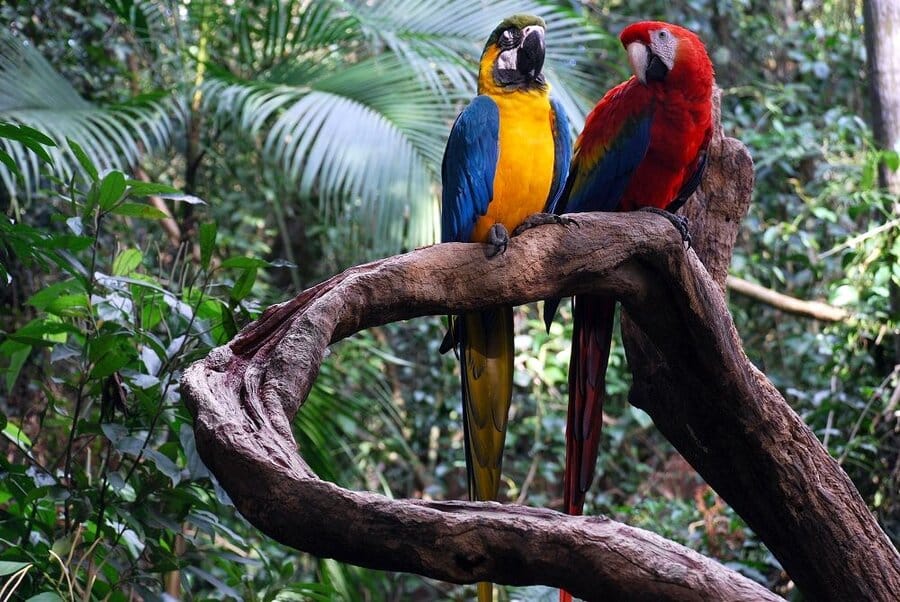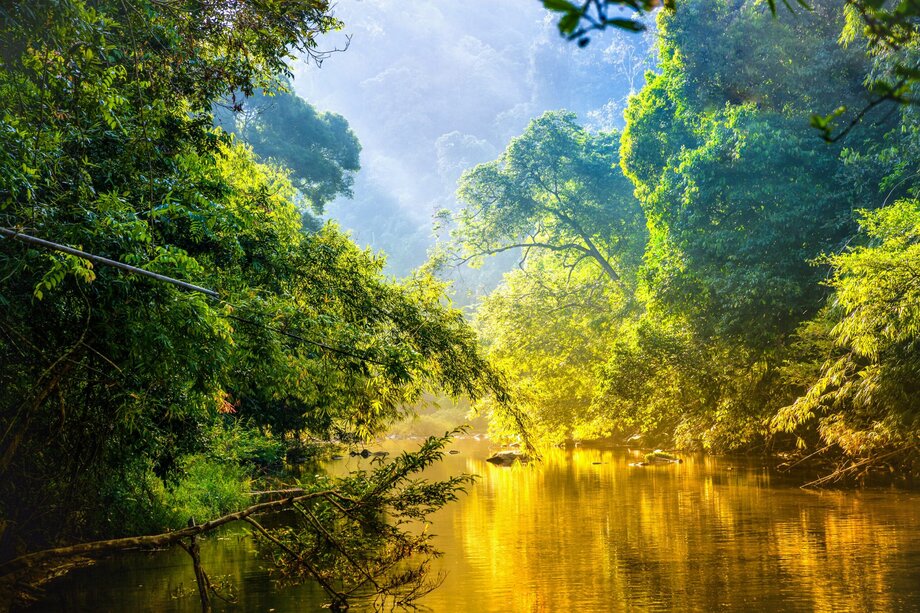
Welcome to the Amazon Rainforest, a mesmerizing world of untamed wilderness and unparalleled natural beauty that spans across nine South American countries.
Covering over 5.5 million square kilometers, the Amazon Rainforest is not only the largest tropical rainforest on Earth but also one of the most biodiverse regions, harboring an astonishing array of plant and animal species.
Exploring this ecological marvel is a dream come true for adventure seekers and nature enthusiasts alike, offering a chance to immerse oneself in a realm of wonder and discovery.
In this comprehensive guide, we invite you to join us on an unforgettable journey through the Amazon Rainforest, where you will uncover hidden treasures, witness extraordinary wildlife, and forge a profound connection with the heartbeat of the planet.
Choosing Your Entry Point:
The Amazon Rainforest spans across multiple countries in South America, each offering its own unique entry points and experiences. Deciding on the right entry point for your Amazon adventure is essential to ensure you make the most of your journey. Here are some considerations to help you choose the best entry point:
Manaus, Brazil:
Manaus, the capital of the Brazilian state of Amazonas, is a popular starting point for exploring the Brazilian Amazon. With its modern infrastructure and well-developed tourism industry, Manaus provides convenient access to the heart of the rainforest.
From here, you can embark on river cruises along the Amazon River, visit wildlife-rich reserves such as the Mamirauá Sustainable
Development Reserve, or venture deeper into the jungle to experience remote communities and pristine habitats. Manaus also offers a range of accommodations, from luxury riverfront hotels to eco-lodges nestled in the jungle.
Iquitos, Peru:
Located in the northeastern region of Peru, Iquitos is the largest city in the world inaccessible by road. This bustling riverine city serves as a gateway to the Peruvian Amazon and offers a distinct cultural experience. From Iquitos, you can embark on unforgettable Amazon river cruises, visit protected areas like Pacaya-Samiria National Reserve, or venture into remote indigenous communities.
The city itself has a vibrant atmosphere, with bustling markets, floating houses, and a rich heritage shaped by the rubber boom era. Choose from a range of accommodations, including lodges and luxury riverboats, to suit your preferences.
Leticia, Colombia:
Leticia, located in the southernmost part of Colombia, is another popular entry point to the Amazon Rainforest. Situated at the meeting point of Colombia, Peru, and Brazil, Leticia offers a unique cross-border experience.
From here, you can explore the Colombian Amazon, visit indigenous communities, and embark on wildlife excursions. The nearby Amacayacu National Natural Park showcases the region’s diverse flora and fauna, while the Yahuarcaca and Tarapoto lakes offer opportunities for birdwatching and piranha fishing.
Leticia provides a range of accommodations, including rustic lodges and eco-friendly resorts.
Other Entry Points:
In addition to Manaus, Iquitos, and Leticia, there are alternative entry points to consider. For instance, Puerto Maldonado in Peru provides access to the southern Amazon, where you can explore the Tambopata National Reserve and experience canopy walkways.
The Ecuadorian Amazon, accessible from cities like Coca and Tena, offers a different perspective on the rainforest with its unique flora and indigenous cultures. Research and compare entry points to determine which one aligns best with your travel preferences, desired activities, and logistical convenience.
Factors to Consider:
When choosing your entry point, consider factors such as accessibility, transportation options, available activities, and the level of infrastructure and services.
Evaluate the type of experience you seek, whether it’s a remote and immersive adventure or a more comfortable and well-developed touristic experience. Additionally, take into account the time and budget you have available, as different entry points may require varying durations and costs for your Amazon exploration.
Engaging with Local Indigenous Communities:
One of the most enriching aspects of exploring the Amazon Rainforest is the opportunity to connect with the local indigenous communities that call this vast ecosystem their home. These communities have inhabited the rainforest for centuries, possessing a deep understanding and reverence for its intricacies.
Engaging with them not only allows for cultural exchange but also provides valuable insights into sustainable living, traditional knowledge, and the profound connection between humans and nature.
Here are some ways to engage with local indigenous communities during your Amazon Rainforest adventure:
Cultural Immersion:
Immerse yourself in the daily lives of indigenous communities by participating in cultural activities and experiencing their traditions firsthand.
Take part in storytelling sessions, traditional dance performances, handicraft workshops, or cooking demonstrations. These interactions offer a window into the rich heritage, customs, and spiritual beliefs of the indigenous cultures, providing a deeper appreciation for their way of life.
Community Visits:
Visit indigenous villages within the rainforest and engage in meaningful interactions with community members.
Some communities warmly welcome visitors, allowing you to witness their daily routines, observe traditional practices, and gain insights into their relationship with the natural environment.
Respect cultural protocols and practices, and seek permission before entering sacred sites or participating in ceremonies. Remember, it is essential to approach these visits with respect, humility, and a genuine desire to learn and connect.
Ethical and Responsible Tourism:
Choose tour operators and accommodations that prioritize responsible tourism and have established relationships with local indigenous communities.
Look for initiatives that are community-led and mutually beneficial, ensuring that the communities are involved in decision-making and receive fair economic benefits from tourism activities.
By supporting responsible tourism practices, you contribute to the preservation of indigenous cultures, their traditional livelihoods, and the conservation of the rainforest.
Traditional Medicine and Healing:
Indigenous communities in the Amazon Rainforest possess deep knowledge of medicinal plants and traditional healing practices.
Seek opportunities to learn about their holistic approaches to healthcare and well-being. Engage in plant medicine workshops, guided forest walks, or visits to medicinal gardens, where you can discover the remarkable healing properties of various plant species and gain insights into indigenous healthcare systems.
Ecotourism and Community-Based Projects:
Support community-based ecotourism initiatives that empower indigenous communities and provide alternative livelihoods.
These projects often involve guided nature walks, river canoe trips, or stays in eco-lodges owned and operated by the communities themselves.
By participating in these activities, you contribute to the sustainable development of indigenous communities while enjoying authentic experiences and fostering cross-cultural understanding.
Responsible Photography and Storytelling:
If you capture photographs or document your experiences with indigenous communities, do so responsibly and with their consent.
Respect their cultural protocols regarding photography and refrain from invasive or exploitative practices. Seek opportunities to share their stories, traditions, and challenges with sensitivity, giving voice to their unique perspectives and advocating for their rights and the preservation of their cultures.
Sustainable Crafts and Artisanal Products:
Support indigenous communities by purchasing authentic handicrafts and artisanal products directly from artisans.
These crafts often reflect traditional techniques and cultural heritage, providing a sustainable source of income for indigenous families. By buying directly from the communities, you help preserve their cultural traditions and contribute to their economic well-being.

More About The Amazon Rainforest
Wildlife Encounters:
The Amazon Rainforest is teeming with an astonishing array of wildlife. Embark on guided jungle hikes, canoe excursions, or nocturnal safaris to increase your chances of spotting unique species like jaguars, giant river otters, monkeys, colorful birds, and elusive reptiles.
Stay alert and attentive to the sights and sounds of the rainforest, and let the expertise of local guides enhance your wildlife encounters.
Navigating the Waterways:
The Amazon River and its tributaries are the lifelines of the rainforest, offering an enchanting network of waterways to explore. Cruise along the mighty Amazon, observing its vastness and witnessing the confluence of different ecosystems.
Consider a multi-day river expedition aboard a comfortable riverboat, allowing you to venture deep into the heart of the rainforest and access remote areas inaccessible by land.
Experience stunning sunsets, embark on smaller boat excursions to hidden lagoons, and immerse yourself in the serenity of the river’s tranquil beauty.
Canopy Walks and Treetop Exploration:
For a unique perspective of the Amazon Rainforest, indulge in canopy walks and treetop exploration. Suspended walkways and observation towers allow you to traverse the lush canopy, granting you panoramic vistas and a chance to observe the forest from the treetops.
The elevated vantage point offers a different dimension to your rainforest experience, providing a closer look at the diverse flora, fauna, and intricate ecosystems that thrive above the forest floor.
Conservation and Responsible Travel:
As a responsible traveler, it’s crucial to support conservation initiatives and minimize your impact on the fragile Amazon ecosystem. Choose eco-friendly accommodations and tour operators that prioritize sustainability and local conservation efforts.
Respect the rainforest’s delicate balance by following Leave No Trace principles, refraining from littering, and avoiding activities that may harm the environment or wildlife.
By practicing responsible travel, you contribute to the long-term preservation of the Amazon Rainforest for future generations.


